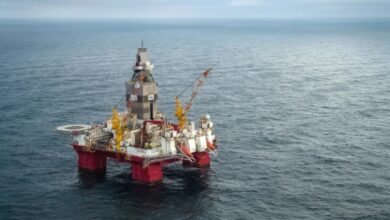Methane hydrate technologies to be tested on Alaska’s North Slope
The US Department of Energy (DOE), ConocoPhillips and the Japan Oil, Gas and Metals National Corp will work together to test innovative technologies for producing methane gas from hydrate deposits on the Alaska North Slope. The tests will use the “Ignik Sikumi” gas hydrate field-trial well, a fully instrumented borehole installed in the Prudhoe Bay region by ConocoPhillips and the Office of Fossil Energy’s National Energy Technology Laboratory earlier this year.
Current test plans call for roughly 100 days of continuous operations from January to March 2012. Tests will include the initial field trial of a technology that involves injecting CO2 into methane hydrate-bearing sandstone formations, resulting in the swapping of CO2 molecules for methane molecules in the solid-water hydrate lattice, the release of methane gas, and the permanent storage of CO2 in the formation. This experiment will be an extension of earlier successful tests of the technology conducted by ConocoPhillips and their research partners in a laboratory setting.
Following the exchange tests, the team will conduct a monthlong evaluation of an alternative methane-production method called depressurization. This process involves pumping fluids out of the borehole to reduce pressure in the well, which results in dissociation of methane hydrate into methane gas and liquid water. The method was successfully demonstrated during a weeklong test conducted by Japan and Canada in northwestern Canada in 2008.
The new testing will take place under a statement for cooperation signed in 2008 and extended in 2011 by DOE and Japan’s Ministry of Economy, Trade and Industry. The production tests are the next step in both US and Japanese efforts to evaluate the response of gas hydrate reservoirs to alternative gas hydrate production concepts. The tests will provide critical information to inform potential future extended-duration tests.
Methane hydrate consists of molecules of natural gas trapped in an open rigid framework of water molecules. It occurs in sediments within and below thick permafrost in Arctic regions and in the subsurface of most continental waters with a depth of approximately 1,500 ft or greater. Many experts believe it represents a potentially vast source of global energy, and DOE scientists have studied methane hydrate resource potential and production technologies for more than two decades.




